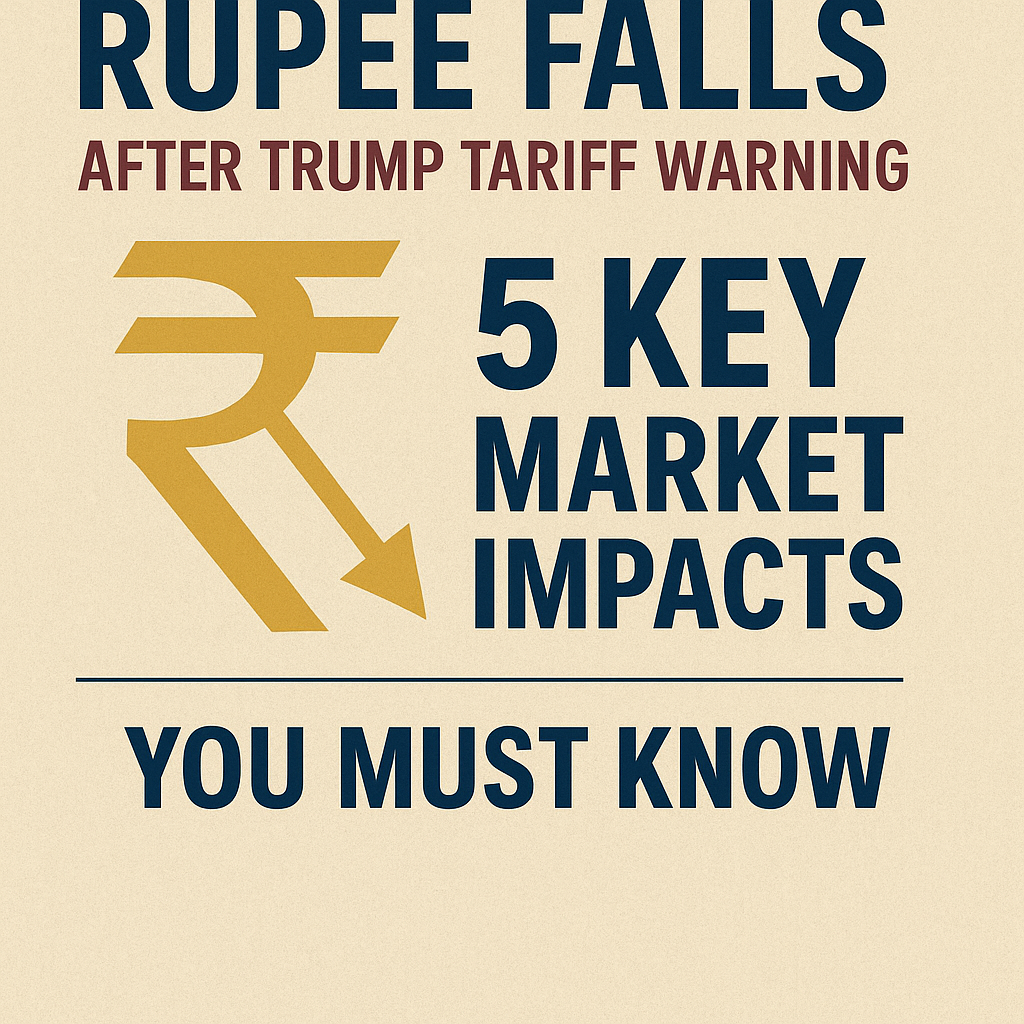Rupee Falls After Trump Tariff Warning: 4 Critical Signals for Indian Economy
Rupee falls after Trump tariff warning as markets across Asia tumble, pressuring India’s currency into the ₹85.48–85.52/USD range on Monday. U.S. President Donald Trump’s renewed threat to impose higher tariffs starting August 1 if trade deals aren’t finalized ignited tension throughout the region. With over 11,000 outage-style reports from emerging markets and equities dipping, here are the 5 critical fallout points that every investor, importer/exporter, and trader should track this week.
1. Asia Suffers: Rupee Falls After Trump Tariff Warning, Mirroring Regional Currency Slump
Following the aggressive tariff rhetoric, the one-month Rupee non-deliverable forward opened at ₹85.48–85.52 compared to Friday’s ₹85.3925—a sharp move in currency markets. This decline coincided with 0.2–0.3% losses in:
-
Offshore Chinese yuan (~7.17/USD)
-
Korean won, Thai baht, Indonesian rupiah
A currency trader commented that while these shifts are “manageable“, the rupee falls after Trump tariff warning tends to destabilize regional risk sentiment and cause ripple effects across Asia’s export-heavy economies.
2. Market Mechanics: Drivers Behind the Drop
Several factors fueled the tumbling rupee:
-
Dollar Strength: The U.S. dollar index rose to ~97.08, making USD-denominated assets more expensive.
-
Stable Treasury Yields: The 10-year U.S. yield remained near 4.33%, keeping dollar demand strong.
-
Oil Decline: Brent crude dropped ~0.8% to $67.80/barrel due to OPEC+ supply hikes—hurting the rupee by increasing import costs.
-
Foreign Selling: FIIs sold $305 million in Indian equities on July 3, compounding currency pressure.
Conclusion: When rupee falls after Trump tariff warning, the combination of rising dollar demand, weaker oil prices, and capital outflows creates sharp—but potentially short-lived—volatility.
3. Rupee Outlook: Does Volatility Stop at ₹86?
Last month, the rupee traded between ₹84.50–₹86.00/USD. With this fresh round of volatility, the critical threshold is ₹86.00—a breakout could trigger stop-loss selling or trigger RBI intervention.
That said, Bangkok-based analysts note Asia’s move “doesn’t change that much,” suggesting the rupee may remain range-bound unless tariffs actually materialize.
4. Trump’s Timeline: Why August Matters
Trump has threatened to reinstate tariffs from August 1 after pausing them for trade talks. Now, with deadlines approaching, markets are pricing in:
-
10% base tariffs
-
Additional 10% “reciprocal” tariffs
-
Another 10% penalty for BRICS-linked countries
Should these go ahead, the rupee falls after Trump tariff warning will shift from speculative to fundamental, with clear downside implications.
5. Impact Beyond Currency: Stocks, Bonds & Imports
⚠️ Stock Markets
-
Asian equity futures dipped
-
Expect correction in Indian benchmarks (Nifty, Sensex) alongside rupee weakness
📉 Domestic Bonds
-
Indian G-secs may decline if capital flow out of EMs persists
-
Rupee drop adds inflationary pressure via import prices
🇮🇳 Trade & Inflation
-
Higher import costs hurt oil and commodity prices, fueling CPI
-
Exporters benefit from weak rupee—but only if global demand holds
Can India–US Mini Deal Offer Rupee Relief?
Reports from CNBC-TV18 suggest a possible mini trade deal within 48 hours. Positive headlines could help soften the rupee’s fall. But until an agreement is sealed, the rupee falls after Trump tariff warning remains the dominant market narrative.
RBI Watch: Will They Intervene?
To cushion the blow, the RBI may:
-
Deploy foreign reserves
-
Provide verbal reassurance
-
Use macro-prudential tools
However, with inflation still a concern, RBI intervention may be limited unless volatility escalates beyond ₹86.
Expert Summary
| Expert | Viewpoint |
|---|---|
| Currency Trader | “Rupee falls after Trump tariff warning, but shifts remain manageable.” |
| FX Strategist | “Still range-bound unless tariffs materialize—watch August developments.” |
| Equity Analyst | “Immediate equity drop possible; long-term outlook depends on fundamentals.” |
Investor Takeaways
Whether you’re an importer, exporter, or investor:
-
Importers: Lock-in FX rates if large payments are due
-
Exporters: A weaker rupee may help margins
-
Investors: Equities and EM exposure may face headwinds
Adopt a hedging strategy if you have external currency exposure or import obligations.
What to Watch This Week
-
July 9–10: Statements from Trumps or US Treasury
-
July 9: Possible finalization of India–US mini-trade deal
-
July 10: RBI FX or verbal intervention
-
August 1: Tariff recoil full effect (if not resolved)
Final Thoughts
When the rupee falls after Trump tariff warning, it reflects a broader global risk recalibration. Even as the currency is currently within range, markets must watch: tariff developments, FX market flows, and RBI responses. With global trade tensions simmering, this volatility may persist—so prepare accordingly.
Source: Reuters
Suggestion: Jio Down in 10+ Cities: Thousands Report No Signal & Internet Outage on July 6

One Comment